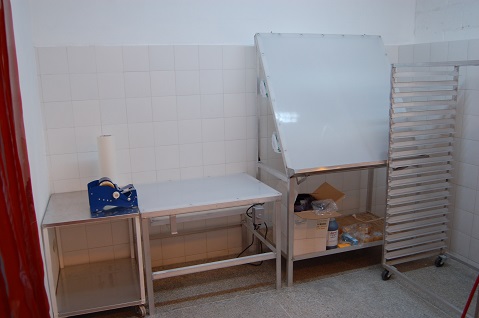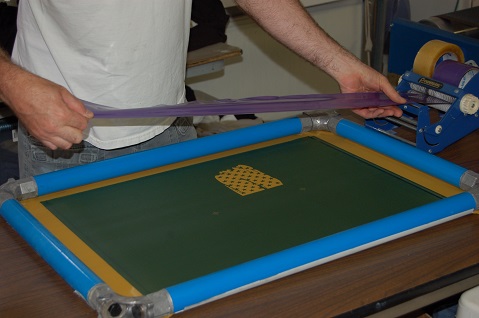Strategy July 27, 2017
Reorganize Your Screen Room
This department shouldn’t be an afterthought. It’s one of the most important parts of the printing process.
Many printers treat their screen department as an afterthought. In truth, the screen room should be the best-thought-out area of your shop. The secret to good screen printing is the screen, and to produce a quality screen, you must have a quality screen room. It’s all about the screen. That’s why we call it screen printing.

A proper work area is important. Here, you see a table for taping screens, a lighted prep area to align art and check for pinholes, and a rack for storing screens. Photo: Lon Winters, Graphic Elephants
The room: Your goal is to have a dust- and contaminant-free environment. Good housekeeping equals good screens since dust, dirt and other contaminants floating in the air have the potential of sticking to a wet screen and causing pinholes. The walls, ceiling and floor of your screen room should have easy-to-clean surfaces. In addition, you should wipe, vacuum and damp-mop these surfaces on a regular schedule. Anything you can do to cut down on screen contaminants is a plus. That means cutting down on traffic in and out of the screen room as well.
Using yellow light is necessary when working with sensitized emulsion and unexposed, coated screens. You can purchase yellow lights as bulbs or fluorescent tubes, but a less expensive option is to purchase yellow filter covers for common white fluorescent tubes from your industrial supplier.
A dehumidifier is the perfect aid to speeding the drying process and should be a part of every screen room. Speeding the drying process gives you better screens. A wet screen after degreasing and a wet emulsion-coated screen attract contaminants until the screen dries. Speed up the drying process, and you’ll have less risk of a contaminated screen.

Taping your screens in the screen room before delivery to the production floor will save time on the press. Photo: Lon Winters, Graphic Elephants
Frames: If you’re using static aluminum frames or wood frames, you might look at upgrading to re-tensionable frames. Despite the higher initial cost, a re-tensionable frame can be stretched back to maximum tension after each reclaiming. And after doing this stretch a few times, the screen mesh will retain this higher tension and last for years on your production floor with proper care. Static frames (glued on mesh) will have to be periodically replaced, so in the long run re-tensionable frames are less expensive and always at maximum tension.
Exposure: No matter what exposure unit you use, you’ll need to calculate exposure time. Your screen-printing supplier will carry an exposure calculator for this purpose. This calculator is actually a film positive with different gradation patterns. Based on the best gradation pattern on the screen after exposure, the calculator will give you the formula to calculate your absolute best exposure time. Use the exposure calculator on all your mesh counts. With age, your light source will lose intensity and require a longer exposure time. It’s a good idea to test with the exposure calculator every three months or so.
The current high-end upgrade to your screen room is a direct-to-screen machine. This device inkjet prints the image onto your screen rather than using a film positive. And there’s an option available to expose the screen to UV light as it exits the machine as well. Due to the higher price, most experts feel you’ll need to process 50-plus screens a day to justify the cost of this machine.
Washing and drying: After exposing your screens, you’ll need a backlit sink and a low-pressure hose to wash them out. This sprayer can be a common garden hose with a spray attachment. (No power washer pressure for screen washout.) The fastest and simplest method to dry the screen after washout is a shop vacuum with a squeegee attachment available from your local hardware store. If you don’t dry the print area completely after washout, the screen could be blocked by clear emulsion running down the mesh. This “glazing” of the screen may not be apparent until the screens are on the press.
By properly equipping your screen room, you can bring your shop to a higher level. A well-organized and equipped screen room can make your work more efficient and improve the entire production process.
***
Terry Combs is a 35-plus-year veteran of the garment-printing industry and has managed production shops large and small across the United States. He has written hundreds of management and technical articles for garment-printing publications and spoken at industry events worldwide. He’s in sales and training with Equipment Zone, Franklin Lakes, NJ, working from Scottsdale, AZ.
